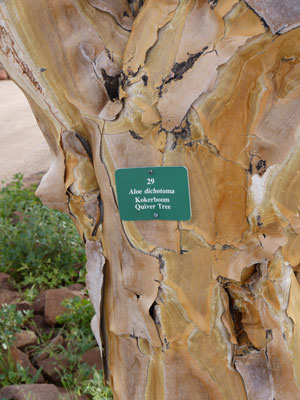The National Botanic Garden of Namibia
Namibia’s National Botanic Garden was right there, according to my map, close by Windhoek’s impressive Parliament Building and a hop, skip and a jump from the city’s landmark Christ Church. But where was it?
As I trudged along streets and roads that invariably didn’t take me to the garden, there was no need to remind me that Windhoek is the capital city of the driest country south of the Sahara. My water bottle had long ago gone empty.
“Can you tell me where the botanical garden is?” I asked passersby along the way. Replies ranged from “I think it’s somewhere over there” to “I didn’t know Windhoek had a botanical garden!” to “What’s a botanical garden?” Finally, one said, “You get to it via Hugel Street, two streets over,” adding that “Hugel” translated to “hill” and that I was in for quite a climb.
Needless to say, my mood was not happy when, at last, I pushed open the wrought-iron gates to the garden — a mood enhanced on the not-happy side when I poked my camera through a wire fence to take a photo of the garden sign only to find the fence electrified!
To collect myself, I sat in the shade of a gracefully drooping moringa tree, as it was labeled, before heading into the garden’s entrance building to ask if Silke Rügheimer, the garden’s director/curator, might be available to tell me a bit about the garden.
The garden’s origins
In 1969 the property was fenced and set aside as a game reserve, I learned from Rügheimer. Paths were laid out and the first trees, planted. Funds, however, soon became depleted and the park was closed. So it remained until 1993, when the National Botanical Institute asked permission to find a permanent home on the property and administer its 12 hectares as a showcase of Namibia’s indigenous flora.
The trees earlier planted — among them a stand of fully grown quiver, seven varieties of acacia, and prehistoric-looking bottle trees with their swollen trunks and sparse branches — provided the foundation for what has become the garden’s ongoing additions of species.
“Unlike many other botanical gardens in the world, ours hasn’t been landscaped or adorned with exotic plants from elsewhere,” Rügheimer told me. “It remains purely and proudly Namibian.”
While the garden was initially designed to showcase species indigenous to Windhoek’s immediate area, Rügheimer has gradually increased its diversity with the addition of flora from far-flung areas of the country.
Seasonal hues
“Every season has its beauty,” Rügheimer said as she handed me a map and encouraged me to go exploring. “During the dry months, the garden is golden and tawny,” she said. “When the rains begin, it instantaneously turns green.”
My late-2014 visit was at the tail end of the rainy season. While the garden had not yet entered its “golden and tawny” season, it had experienced several weeks of dry weather and was no longer lushly green.
Paths and stone stairways took me through an enormous collection of succulents, through the quiver tree forest, past the picnic area, through a planting of lilies (which I was told would erupt into extravagant bloom when doused with a drizzle), specimens of aloe and euphorbia.
I passed plants familiar to my northern California home landscape and others, like the Pachypodium lealii with its strange bulbous trunk and topknot of sparse branches, that appeared absolutely prehistoric. Interesting as it was to read plant labels, the property’s hillside location captivated me with its stunning views of the city below and surrounding landscape.
Transformed overnight
I’d arrived in Windhoek a day prior to my participation in an ElderTreks tour of Southern Africa (Oct. ’14, pg. 6). The destination for our first night’s stay was the Namib Naukluft Lodge, located on a 25,000-hectare private reserve, its cluster of cottages banked hard against a rock hill with golden savannah grass billowing toward red mountains in the distance.
A thunderstorm roared through that night with an accompanying drenching downpour. In the morning, I was astounded to see that the golden savannah had erupted into a landscape of wildflowers — blues, yellows, reds — giving me sudden insight as to what occurs when rain falls on Namibia’s National Botanic Garden.
Periodic late-afternoon and evening showers followed us through our days in Namibia, transforming dusty plains and rocky mountain peaks into botanical gardens overnight. Entire fields turned into stunning carpets of aptly named yellow devil’s thorn. Gorgeous to look at, but don’t even consider walking across it in your flip-flops!
Planning a visit
The National Botanic Garden of Namibia (phone +264 61 202 2014, www/nbri.org.na) is located at 8 Orban Street in Windhoek. The garden is open 8 a.m. to 5 p.m. Monday to Friday plus 8 a.m.-11 a.m. every first Saturday. Admission is free.
Words to the wise — paths and stone steps are uneven throughout the garden; wear sturdy walking shoes. Carry bottled water with you and wear a hat. Consider arriving by taxi, asking first if the driver knows of the garden’s existence and is acquainted with its location.
Email Yvonne Horn at [email protected]. Also visit www.thetraveling
gardener.com.



